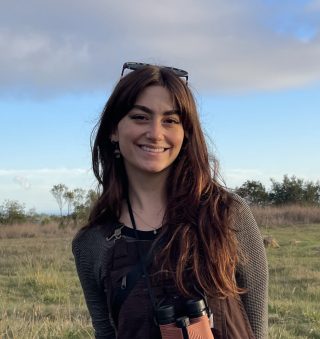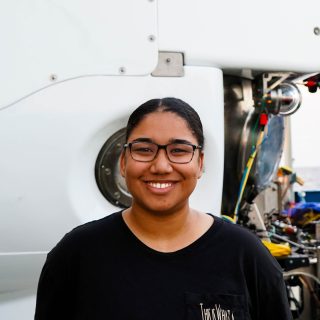Traducción al español a continuación.
This expedition is in collaboration with the Galápagos National Park, Charles Darwin Foundation, and the local navy, INOCAR.
Situated at depths of up to 5000 meters, hydrothermal vent systems are complex and formidable ecosystems. Vent environments are blanketed in profound darkness, exist under immense pressures, and emit fluids of remarkable heat, toxicity, acidity, and hypoxia (low-oxygen), collectively shaping their extraordinary and challenging nature. As the hot, metal-rich hydrothermal fluid mixes with the surrounding, near-freezing deep-ocean water, chimney structures – composed of minerals like metal sulfide – are formed that can ascend to heights exceeding 10 meters.
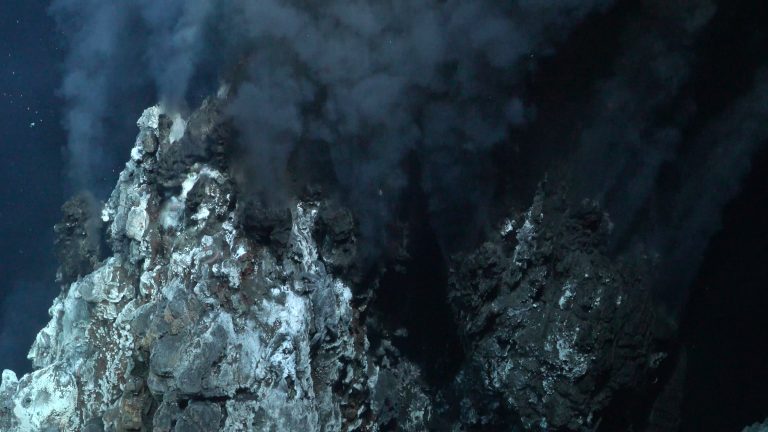
Despite these hostile conditions, hydrothermal vents are flourishing with an abundance of invertebrate species which are reliant upon microbial symbionts for their nutrition. These microbial symbionts reside within the tissues of the host organisms, using chemicals derived from the hydrothermal fluid—such as hydrogen sulfide and methane—to harness energy for the synthesis of organic matter via a process termed chemosynthesis (in contrast to photosynthesis, which uses sunlight). This dependence on symbionts assumes critical significance, as the deep-sea is otherwise very nutrient-depleted and therefore typically sustains sparse populations of animals. Thus, contrary to their infernal appearance, these vents are remarkably hospitable–provided, of course, that one establishes the proper symbiosis (a fact evidenced by the considerable animal biomass thriving in these environments).
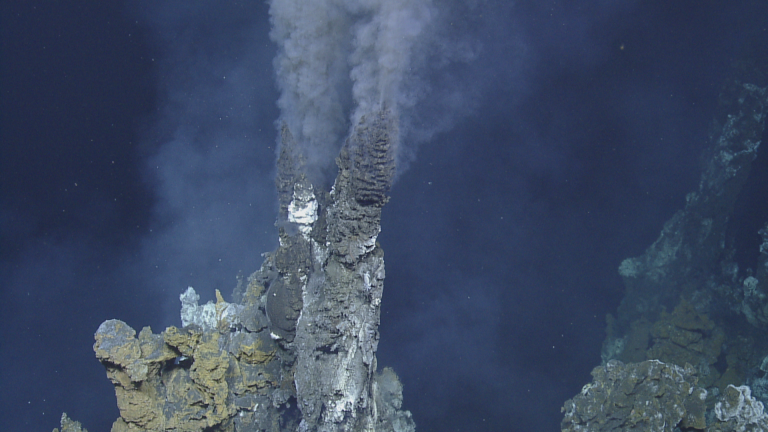
In stark contrast, we humans are not adapted to survive these conditions. Instead, we necessitate pioneering technological advancements to facilitate our observation, sampling, and comprehension of these ecosystems. During this expedition aboard the R/V Falkor (too), we are sending SuBastian, a remotely operated vehicle (ROV), to the Western Galapagos Spreading Center (WGSC) with the aim of uncovering novel hydrothermal vent fields and deepening our understanding of those already known. The ROV SuBastian is equipped with instruments that are engineered to withstand great depths, including bespoke, high definition camera equipment, allowing us to have a 2D view of the area, but from several angles. Piloting requires precision and coordination as the ROV hovers over the rugged seafloor. SuBastian wields titanium robot arms thousands of meters beneath the surface while contending with surface and subsurface currents. Piloting skill, as well as the assistance of technologies like dynamic positioning (which maintains the ships position during dives), are paramount for successful dives.
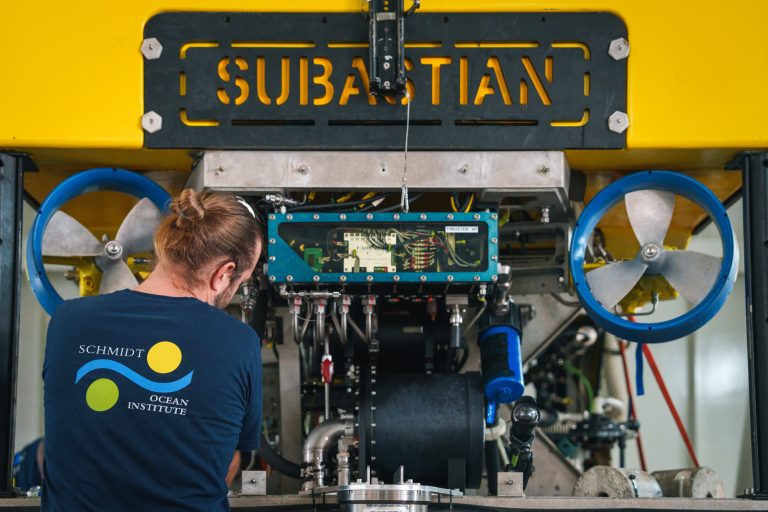
The unique conditions of hydrothermal environments, such as those at the WGSC, present challenges in retrieving samples in ways that preserve their integrity. Collecting fragments of sulfide chimneys for mineralogical studies removes the structures from their low-oxygen environment, prompting alterations as they ascend to the surface, thus requiring swift handling and storage methods to prevent oxidation. Similarly, deep-sea animals struggle to maintain their integrity when removed from the intense pressures and toxic fluids characteristic of their habitat. Vent animals are adapted to those crushing pressures; to them, life at the surface is “extreme”. To maintain the health of these animals at the surface, scientists must keep them in extremely cold seawater, or, ideally, in high-pressure titanium tanks with fluid chemistry simulating those of hydrothermal vents.

Hydrothermal fluids can present in many forms, each varying in temperature and chemical composition and require their own unique sampling and processing. To capture fluid samples for geochemical analyses, Isobaric Gas Tight (IGT) samplers are employed. These titanium samplers are not only able to sample fluids under extreme temperatures and pressures, but can keep samples at deep-sea pressures (~250 atm, at 2.5 km depths) as they are brought to sea level (~ 1 atm). IGTs have the additional benefit of retaining the dissolved gasses in fluid samples. Measuring the abundance of gasses (e.g. helium, carbon dioxide, methane) released by these vents aids scientists in understanding sub-seafloor processes like volcanic eruption or biological activity.
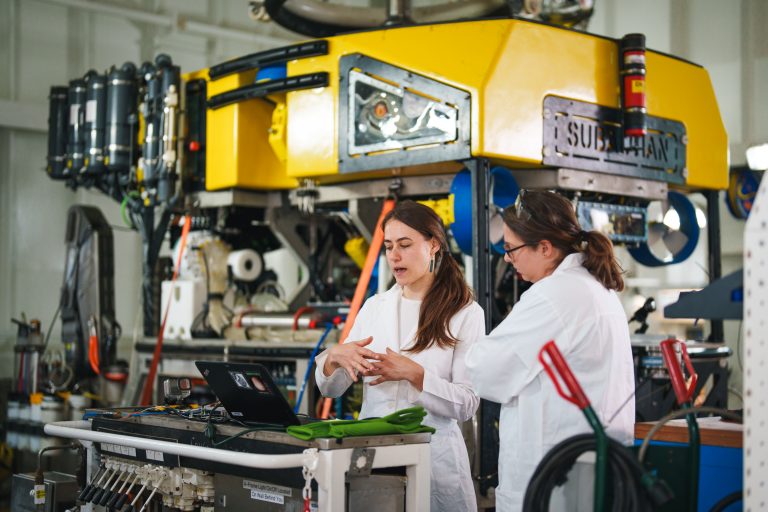
Obtaining what would-be considered simple microbiological water samples if in coastal or aquatic settings demands intricate engineering when in the deep-sea. On this WGSC research expedition, we will also be deploying a SuPR Sampler (Suspended Particulate Rosette Sampler), the first technology capable of in-situ collection of discrete, precise, and high-volume fluid samples in these harsh environments, an innovation that has only existed for roughly a decade—a testament to the profound complexity of deep-sea research. Access to this type of equipment has transformed the way scientists study the microbiology of deep-sea hydrothermal vent fluids.

Humans are decidedly ill-suited for intimate exploration within the deep Ocean. Foraying to such depths requires creative and collaborative efforts between engineers and scientists to craft technologies that are tolerant of water, pressure, temperature, and acidity, among other factors, to collect even some of the most ostensibly simple forms of samples. Thanks to SuBastian and the efforts of the Falkor (too) crew, scientists are able to study and explore these remarkable deep-sea environments.
Obtener Muestras en un Entorno Hostil
Situados a profundidades de hasta 5.000 metros, los sistemas de respiraderos hidrotermales son ecosistemas complejos y formidables. Los respiraderos están envueltos en una profunda oscuridad, están sometidos a presiones inmensas y emiten fluidos de gran calor, toxicidad, acidez e hipoxia (bajo nivel de oxígeno), lo que determina su extraordinaria y difícil naturaleza. Al mezclarse el fluido hidrotermal caliente y rico en metales con el agua oceánica circundante, casi helada, se forman estructuras en forma de chimenea -compuestas de minerales como el sulfuro metálico- que pueden ascender a alturas superiores a los 10 metros.
A pesar de estas condiciones hostiles, las fuentes hidrotermales están floreciendo con una abundancia de especies de invertebrados que dependen de simbiontes microbianos para su nutrición. Estos simbiontes microbianos residen en los tejidos de los organismos huéspedes y utilizan sustancias químicas derivadas del fluido hidrotermal, como el sulfuro de hidrógeno y el metano, para obtener energía para la síntesis de materia orgánica mediante un proceso denominado quimiosíntesis (a diferencia de la fotosíntesis, que utiliza la luz solar). Esta dependencia de los simbiontes adquiere una importancia crítica, ya que, por lo demás, las profundidades marinas carecen de nutrientes y, por tanto, suelen albergar poblaciones escasas de animales. Así pues, en contra de su aspecto infernal, estos respiraderos son extraordinariamente hospitalarios, siempre que se establezca la simbiosis adecuada (como demuestra la considerable biomasa animal que prospera en estos entornos).
En marcado contraste, los seres humanos no estamos adaptados para sobrevivir a estas condiciones. En su lugar, necesitamos avances tecnológicos pioneros para facilitar nuestra observación, muestreo y comprensión de estos ecosistemas. Durante esta expedición a bordo del R/V Falkor (too), estamos enviando a SuBastian, un vehículo operado remotamente (ROV), al Centro de Propagación de Galápagos Occidental (WGSC) con el objetivo de descubrir nuevos campos de respiraderos hidrotermales y profundizar nuestra comprensión de los ya conocidos. El ROV SuBastian está equipado con instrumentos diseñados para soportar grandes profundidades, incluido un equipo de cámaras de alta definición hecho a medida, que nos permite tener una visión 2D de la zona, pero desde varios ángulos. El pilotaje requiere precisión y coordinación mientras el ROV planea sobre el escarpado fondo marino. SuBastian maneja brazos robóticos de titanio a miles de metros bajo la superficie mientras lucha con las corrientes superficiales y subsuperficiales. La habilidad de pilotaje, así como la ayuda de tecnologías como el posicionamiento dinámico (que mantiene la posición de la nave durante las inmersiones), son fundamentales para el éxito de las inmersiones.
Las condiciones únicas de los entornos hidrotermales, como los del WGSC, plantean retos a la hora de recuperar muestras de forma que se preserve su integridad. La recogida de fragmentos de chimeneas de sulfuro para estudios mineralógicos saca a las estructuras de su entorno de bajo oxígeno, lo que provoca alteraciones a medida que ascienden a la superficie, por lo que requieren métodos de manipulación y almacenamiento rápidos para evitar la oxidación. Del mismo modo, los animales de las profundidades marinas luchan por mantener su integridad cuando se les separa de las intensas presiones y fluidos tóxicos característicos de su hábitat. Los animales de ventilación están adaptados a esas presiones aplastantes; para ellos, la vida en la superficie es “extrema”. Para mantener la salud de estos animales en la superficie, los científicos deben mantenerlos en agua de mar extremadamente fría o, en el mejor de los casos, en tanques de titanio a alta presión con una química de fluidos que simule la de los respiraderos hidrotermales.
Los fluidos hidrotermales pueden presentarse de muchas formas, cada una de las cuales varía en temperatura y composición química, y requieren su propio muestreo y procesamiento. Para obtener muestras de fluidos para análisis geoquímicos, se emplean muestreadores Isobaric Gas Tight (IGT). Estos muestreadores de titanio no sólo son capaces de tomar muestras de fluidos a temperaturas y presiones extremas, sino que pueden mantener las muestras a presiones marinas profundas (~250 atm, a 2,5 km de profundidad) mientras se llevan al nivel del mar (~ 1 atm). Los IGT tienen la ventaja adicional de retener los gases disueltos en las muestras de fluidos. La medición de la abundancia de gases (helio, dióxido de carbono, metano, etc.) liberados por estos respiraderos ayuda a los científicos a comprender los procesos del subsuelo marino, como las erupciones volcánicas o la actividad biológica.
La obtención de lo que podrían considerarse simples muestras microbiológicas de agua en entornos costeros o acuáticos exige una compleja ingeniería en aguas profundas. En esta expedición de investigación del WGSC, también desplegaremos un muestreador SuPR (Suspended Particulate Rosette Sampler), la primera tecnología capaz de recoger in situ muestras de fluidos discretas, precisas y de gran volumen en estos duros entornos, una innovación que sólo existe desde hace aproximadamente una década, testimonio de la profunda complejidad de la investigación en aguas profundas. El acceso a este tipo de equipos ha transformado la forma en que los científicos estudian la microbiología de los fluidos de los respiraderos hidrotermales de aguas profundas.
El ser humano no está preparado para explorar las profundidades oceánicas. Llegar a tales profundidades exige un esfuerzo creativo y de colaboración entre ingenieros y científicos para crear tecnologías que toleren el agua, la presión, la temperatura y la acidez, entre otros factores, para recoger incluso algunas de las muestras más aparentemente sencillas. Gracias a SuBastian y a los esfuerzos de la tripulación del Falkor (too), los científicos pueden estudiar y explorar estos extraordinarios entornos de aguas profundas.
